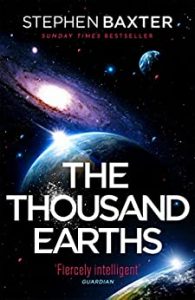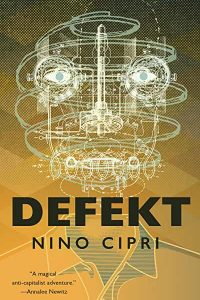Russell Letson Reviews The Thousand Earths by Stephen Baxter
 The Thousand Earths, Stephen Baxter (Gollancz 978-1 473-22890-0, £22.00, 586 pp, hc) September 2022.
The Thousand Earths, Stephen Baxter (Gollancz 978-1 473-22890-0, £22.00, 586 pp, hc) September 2022.
I don’t think it’s an exaggeration to say that Stephen Baxter’s work sprawls, narratively, spatially, temporally, conceptually, and cosmologically. He also has a fondness for extravagantly displacing his protagonists and for setting his stories in strange and mysterious environments. And he does love a comprehensive, apocalyptic disaster – see his recent World Engines: Destroyer or Galaxias. What I find especially interesting is how many ways he manages to reconfigure these motifs, tropes, and options in his latest, The Thousand Earths.
The novel alternates two narrative threads whose precise relationship is hinted at but not made clear for most of the book’s length. The novel is named for the setting of one thread: somewhere and somewhen, there is a flat, artificial, human-inhabited world, one of ‘‘the bright blue-green diamonds of the thousand Earths in their regular array’’ (perhaps along the lines of a Dyson swarm), and it is decaying – literally crumbling along its edges at a predictable rate of 60 meters a day. The girl Mela sees this for herself at age 12 when her parents take her to the Perimeter to witness the destruction as it proceeds:
The grassy sward she walked on came to a visible end, not far beyond the crimson rope, like the edge of a ragged cliff in some storybook depiction of the Heartland Mountains. Beyond that, only a pearly, featureless light…. She did see a fence, running down to the edge and ending in a ragged, dangling rip – and then, further back, what looked like a collapsed house – or rather, half-collapsed. Somebody’s home, falling into – what?
The experience shapes the next 30 years of her life, as she (like everyone else) copes with the creeping and then galloping disaster. Mela’s world is filled with parallels to what we can see on the news any given morning: guarded borders, refugee caravans and camps, opportunistic exploitation and abuse, and all the varieties of response to massive dislocations.
The other story line will eventually, somehow, converge with Mela’s. It begins with the departure of a 22nd-century exploratory round trip to the Andromeda galaxy, which is predicted to collide with the Milky Way in a few billion years. This supremely unlikely expedition depends on some miraculous enabling starship technology and eventually on the stubborn dedication of its sole surviving member, John Hackett. But we barely hear about Andromeda. Instead, the story picks up on Hackett’s return to Earth five million years later to find what has become of humankind, which has managed to survive in a recognizable state, even though the homeworld is much changed. And the Andromeda mission is just the start of Hackett’s travels, which take him on a series of vastly longer voyages, making him into a temporal tourist who witnesses the fate of our species and its solar system and eventually of much more.
The two story lines operate in quite different modes and have different emotional effects. Mela’s story is part bildungsroman and part slow-motion disaster tale, and her life is dominated by her efforts to mitigate the effects of a collapsing social and physical environment on those fleeing the relentless advance of the Perimeter that is shrinking the world. These ‘‘Immies’’ – Immigrants – are refugees lacking the paperwork (or means or political influence) to ensure a safe harbor in some untouched city or territory, fenced out and left to fend for themselves, often scorned by the (so far) safe citizenry and abused by city border guards.
Hackett’s thread, on the other hand, is a kind of Wellsian-Clarkean tale of temporal-cultural displacement with a big dash of utopian possibilities – a far future of miraculous technologies, of Eloi without Morlocks – against a background of Stapledonian cosmic change. And Hackett’s time-dilated voyages increase by orders of magnitude, taking him deep into the future and the senescence of the universe.
As fantastical as the ideas on both sides of this novel are, Baxter plays the hard-SF game with net up, at least insofar as every major element is rooted in serious science – or at least serious scientific speculation – and he shows his work in an Afterword that lists more than a half-dozen sources/inspirations. Nor is it all science. The social disruptions of Mela’s story are modeled in part on dislocations familiar from the last two centuries of Earthly history, from the Trail of Tears to World War II to the partition of India.
These wildly different story lines do converge, though their thematic resolution may not click together as neatly as one might want. I suspect that the proper position from which to see this novel may be the context of Baxter’s earlier work, which often returns to questions of our place among the infinities (to appropriate Robert Frost’s phrase). In fact, much of his fiction operates as an intellectual/emotional supercollider in which mind-bending cosmic questions are smashed into social and personal worlds at high energy levels. The resulting shower of effects – special and emotional and artistic – are what science fiction is designed to produce.
Russell Letson, Contributing Editor, is a not-quite-retired freelance writer living in St. Cloud MN. He has been loitering around the SF world since childhood and been writing about it since his long-ago grad school days. In between, he published a good bit of business-technology and music journalism. He is still working on a book about Hawaiian slack key guitar.
This review and more like it in the November 2022 issue of Locus.
 While you are here, please take a moment to support Locus with a one-time or recurring donation. We rely on reader donations to keep the magazine and site going, and would like to keep the site paywall free, but WE NEED YOUR FINANCIAL SUPPORT to continue quality coverage of the science fiction and fantasy field.
While you are here, please take a moment to support Locus with a one-time or recurring donation. We rely on reader donations to keep the magazine and site going, and would like to keep the site paywall free, but WE NEED YOUR FINANCIAL SUPPORT to continue quality coverage of the science fiction and fantasy field.
©Locus Magazine. Copyrighted material may not be republished without permission of LSFF.






